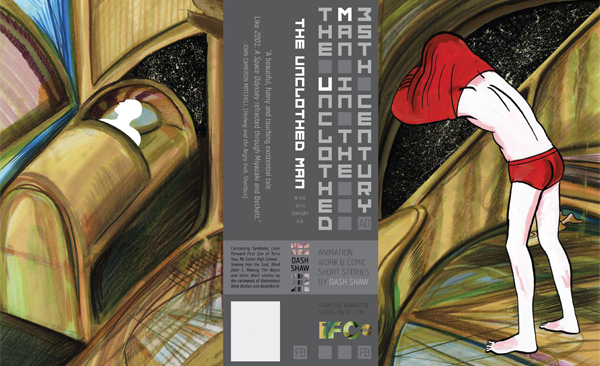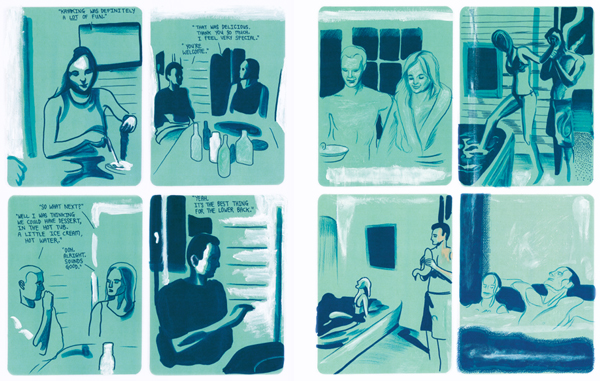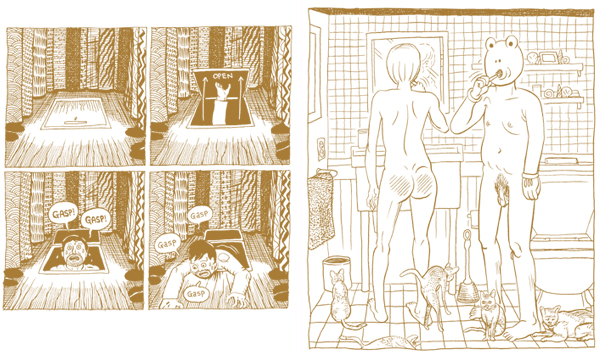
In one of my columns a couple of months ago I mentioned cartoonist Dash Shaw as one of the most exciting new creators working in comics today, and his upcoming book, The Unclothed Man in the 35th Century AD (Fantagraphics, $19.99), as the one I was looking forward to the most this year. A collection of new stuff and previously released short stories and rarities, it’s currently set for a December 30th release, and for it Dash has teamed up with IFC in order to create a series of animated shorts to be shown on their website.
From the press release:
“Each episode of this four-part Web series chronicles Rebel X-6, a man who works for an anti-droid organization in a futuristic world where student artists can no longer draw the living human form. Challenging the convention of hiding the use of line in animation and using an intricate, organic drawing style, Shaw attracts attention to each frame as a complete illustration. With an uplifting, constantly evolving soundtrack that mirrors Shaw’s work, he uses surreal dreams and an achingly human touch to bring his characters to life.
The series’ animated human hero, Rebel X-6, sets out on a quest to initiate change in the 35th Century A.D. An artist guild that believes living people should model for live drawings instead of droids in art class hires Rebel X-6. Rebel X-6’s assignment is to enter Art School 46 posing as “Model-Droid #343.” He must appear life-like but take on the characteristics of standard model droids, which do not laugh, cry, swear or exhibit other human shortcomings. His mission is to subvert the school’s ban on drawings of real humans by tricking the students into drawing him. His journey ends with a new compatriot and understanding of the humanity that surrounds him.
The Unclothed Man in the 35th Century AD is Shaw’s first book since his breakthrough graphic novel of 2008, Bottomless Belly Button, which was named Publishers Weekly’s best graphic novel of 2008 and one of Entertainment Weekly’s top ten books of 2008, among numerous other accolades. The book also collects Shaw’s acclaimed, genre-bending short stories from MOME, including Look Forward, First Son of Terra Two, Galactic Funnels, Outstanding Story, Satellite CMYK and Making the Abyss, a fictionalized story of a surreal film set filled with nuclear tanks, hot tubs, and blind ambition.”
I recently had the chance to briefly discuss the project with Dash:
BIG SHINY ROBOT: I plugged the Unclothed Man in one of my columns a couple of months ago, based on the strength of your previous work, specifically the MOME short stories. Are all of them included in the book? And what else is in it?
DASH SHAW: All of them are in the book except for “Train” because I looked at it again and it sucked too hard. Some of them have been slightly changed for this collection. An older comic from 2005 called “Cartooning Symbolia” is in it. I still liked it for some reason. A new story called “The Uncanny Reproduction” is in it. And the first 24 pages of the book have the Unclothed Man short stories plus backgrounds and storyboards and a flip book from the animated series. The first 24 pages are like an “animation art book” and the next 80 pages have the short stories.

BSR: So, other than “The Cartographer,” of which I only know from the back pages of The Mother’s Mouth, I am not aware of any other forays of yours into animation or film. Is this something you have been doing or interested in doing for a while now? And how did the IFC thing come about?
SHAW: I did animations for Bottomless Belly Button and BodyWorld, just one minute animation tests. Those are online if you look for them. I’ve always liked animation and watched a lot of cartoons and collected animation art books. The IFC thing came about because I showed them the animations for Bottomless and BodyWorld and the Unclothed Man comic. Based on that, they said “okay” for the animated series.
BSR: Speaking of BodyWorld, this acclaimed webcomic of yours is about to be published as a book by Pantheon. Having read it, I can imagine some instances where the translation from web to print would be rather difficult. What are some of the differences between the two?
SHAW: The differences are many, and most of them are probably obvious. Webcomics aren’t printed. There aren’t any “pages.” It was serialized online, rather than one long reading experience. The print version has new material and I made a lot of changes to the comic. I’d change the colors or add different elements in a way that I think favors the print format. I just got a dummy of the book to see how the covers and everything will look and I’m very happy with it. Pantheon is smart. They believe in the beauty of print and they believe people will shell out for a nice book, even though a different version of the same story is online. They have a lot of faith in the new material and the book as an object.
BSR: A lot of your previous work, like Love Eats Brains and Mother’s Mouth, was done at least partially in color, but eventually published in black and white only. Why is that?
SHAW: You’ve done your research! It’s because I wasn’t thinking about what I was doing at the time. I did those while a student at the School of Visual Arts, where I’d show the originals. Sometimes I’d do the originals in color and sometimes in black and white. When they were printed, it made more sense to just do a gray book then figure out how to make the color pages printed in color and the black and white pages in black and white. Really, the honest answer is that I wasn’t thinking about it as much as I guess I should have.
BSR: I’ve followed your work for some time now, and you have rather quickly established yourself as a creator to watch out for. Your climb up the publishing ladder, from Oddgod Press (a publishing operation run by a Richmond, VA comics retailer) to Pantheon, certainly seems to reflect that. Is the pressure greater now, or do you not concern yourself with the commercial aspects of your work until after it’s completed, if at all?
SHAW: This is a long answer. Oddgod Press published Love Eats Brains because they asked me about it. I know those guys because I’d shop there when I lived in Richmond. And then I did a collection called Goddess Head because I used to contribute to an anthology called Garish Zow and one of the editors called me and asked about doing a collection of my shorts. So things would happen pretty organically for a while, but those felt like weird arrangements, like Tim Goodyear, who published Goddess Head, took a loan out from a bank to do it! Ha ha. It was awesome that he did it (I mean, I love Tim), but I think he lost a lot of money on it. I kept applying for Xeric Foundation grants to self-publish and I kept losing. And then Fantagraphics did Bottomless Belly Button and they’d publish me in MOME, so then all of the comics I’d been drawing for a few years would now have a regular publisher. I’d also done half of BodyWorld by the time Bottomless came out. BodyWorld started online in 2007. But after Bottomless came out, I was going to have to get a day job. I’d run out of the money I’d saved while living so cheaply in Richmond. So I called Fantagraphics and told them I was going to try to sell BodyWorld. They understood. I mean, I guess what I’m saying is that all of these projects I was doing anyway. I’ve never sold a treatment and then executed something with the expectations of the publisher looming over my shoulder. By the time I got the advance for BodyWorld I was drawing the last chapter of it. These comics were going to exist in some form anyway. It’s all been a combination of drawing a ridiculous amount and total luck.

If there’s a way to do what I’m already doing and luck into a situation where I don’t have to think about money, because I have enough to live off of for a while, I’m going to try to get in that situation. I think a lot of it stems from my general hatred of illustration work. I hate illustration gigs. I tried to get them (for money) for a while, and I’d always half-ass it because I hated doing it. I hated feeling like I had to draw consistently, in some consistent “style.” I hated everything about illustration. So after having that experience for a couple years, I just decided I’m not an illustrator and I’m not going to do work-for-hire and I don’t want any commercial expectations and that I’d just do whatever I wanted to do for as long as I possibly could. If I run out of money, I’ll move back to Richmond, where I paid 200 dollars a month for a shitty room, and work as a figure-drawing model again for 12 bucks an hour. I drew all of Bottomless that way, but right now I have even more time to do whatever I want. I don’t know how long it’ll last.
BSR: So, do you read a lot of other people’s comics? Are there any of your peers whose work you would say you admired?
SHAW: I basically only read comics that I get at conventions now, because when I’m at home I’m just drawing, and when I’m on the subway I’m reading a magazine or an all-word book. But I got a lot of comics at the Brooklyn Comics and Graphics Festival this past weekend. It was run by my friends Dan Nadel, the Picturebox publisher, and Gabe Fowler, the Desert Island comic store owner. There was a lot of good stuff there. I got new minis from Matthew Thurber and C.F. and Anya Davidson and they’re all really great. Those are available on the Picturebox website. I recently got to collaborate with two peers I admire: Tom K (who does amazing short stories for MOME), we did a comic for the next volume of MOME about computer rendered society; and Jesse Moynihan (who does a webcomic called “Forming” on his website) who wrote a story about his father and the TV show Lost that I drew that’ll be a mini comic insert in a forthcoming issue of The Believer magazine. I’d name more people but I’d feel like a dick if I left someone out. I probably already forgot someone.
BSR: Gary Panter strikes me as an obvious influence, but who are some other creators you would say have shaped your artistic sensibilities and style?
SHAW: I haven’t gotten Gary for a while, nowadays people always say Mazzucchelli. But I’ve ripped off of both of those guys. When someone tells me who they think my influences are, it usually says more about the comics they read. When Mazzucchelli flipped through “Bottomless” years ago, he said: “looks like manga.” Because he looks at the same manga I look at. But for a lot of people it’ll look like something else. Anyway, instead of listing a bunch of people I’ll just name three people who I’ve learned a lot from in college and I think deserve more attention: 1. Keith Mayerson’s comic Horror Hospital Unplugged, 2. Thomas Herpich’s comics Cusp and Gongwanadon, 3. Hal Hartley’s movies.
BSR: Finally, what’s next for you, Dash?
SHAW: I’m working on an animated feature called “Slobs and Nags” and a comic called “Torture Hospital.” I don’t want to say more about them because I don’t want to jinx it.
BSR: Thanks again, and best of luck!
You can view the animated shorts for The Unclothed Man in the 35th Century here. To pre-order the book, talk to your local retailer, or click on the image below:
